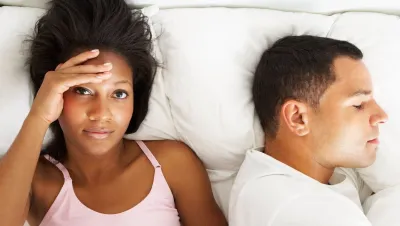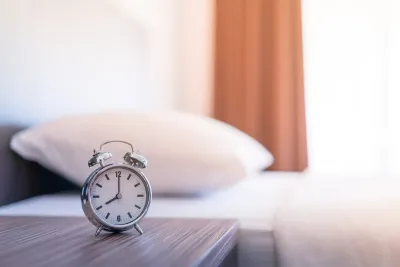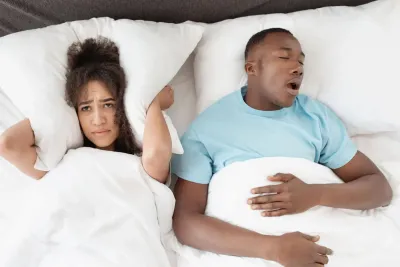
Key Takeaways
- Common Conflict: Disagreements over bed temperature are one of the most frequent sleep issues couples face.
- Temperature Science: The ideal temperature for sleep is typically between 60–67°F, but personal preferences vary widely.
- Relationship Impact: Sleep struggles—like overheating or freezing—can lead to poor rest and even relationship strain.
- Sleep Technology: Dual-zone bed cooling systems (like the Chilipad Dock Pro) let each person control their side of the bed.
- Great Sleep, Together: Personalized temperature control leads to deeper sleep, better mood, and a stronger connection.
Bed temperature, it seems, is nearly as bad as snoring when it comes to couples attempting to remain comfortable in the same bed night after night. Typically, one person is hot, restlessly removing the covers while disrupting their partner's sleep.
You're not alone if you have trouble sleeping at night and selecting the perfect sleep temperature for sleeping well. A study found that approximately 85% of people report having problems falling asleep when it's time for bed, women more so than men. [1]
Do You Disagree About Sleep Temperature? We Can Help!
Our sleep systems, featuring dual-side temperature zones, offer a perfect solution for many couples with different temperatures for sleep. Couples can independently set their ideal temperature, ranging from 55-115ºF, ensuring comfortable and personalized sleep conditions.
Common Sleep Factors
Various personal factors can cause this problem, including money worries, stress, problems with sleeping hot in the workplace, etc. What if you're sharing the bed with a significant other?
Some claim that they have trouble sleeping with another individual because they are disrupted by the other's restlessness and ideal temperature for sleep.
If you're having the same issue with your significant other, you can implement various creative strategies to make your slumber together more peaceful.
Recently, many couples are claiming to be happier with what can be called “sleep divorce.”
Discover more about sleep divorce, including what it is, when to consider it, and additional insights, by reading Navigating the Complexities of Sleep Divorce: Strategies for Success.
In other words, sleeping in different beds or rooms from the other partner. About 30-40% of couples have tried sleeping in one bedroom with different beds to make their sleep more restful. [2]
While the nickname for this phenomenon sounds more ominous than it is for some couples, you could also miss out on some substantial health benefits when you're sleeping separately.
Did You Know: A recent American Academy of Sleep Medicine (AASM) survey indicates that more than one-third of people occasionally or consistently sleep in another room to accommodate a bed partner. The survey found that men are more likely than women to sleep in another room, with 45% of males reporting that they occasionally or consistently do so, compared to only 25% of females. [3]
Below, we'll discuss the benefits of couples sleeping together; it's important to consider that this can often be a more favorable option than a sleep divorce. Sleeping together fosters emotional and physical intimacy and can lead to great sleep solutions through mutual understanding and compromise.
Couples Sleep Statistics
Exploring the dynamics of couples sleep reveals some intriguing statistics. From how sharing a bed affects sleep quality to disagreements over room temperature, these numbers shed light on common challenges couples face at bedtime:
- According to a recent study, 63% of couples sleep apart for most of the night. [4]
- 58% of Couples Disagree on Optimal Room Temperature for Sleep [5]
- Many couples experience 50% more sleep disturbances when sharing a bed than when sleeping alone. [6]
Related Blog: Learn more about the sleep trend for couples, the Scandinavian Sleep Method.
What is the Ideal Sleep Temperature?
What is the best temperature for sleep? Some say that the room temperature for the best sleep is between 60 and 68 degrees. [7] But let's say you prefer to sleep at warmer temperatures while your partner prefers to sleep cooler at night. Most experts agree that bedroom temperature can affect the quality of your sleep.
Some may not know that there are products on the market that can help create an amicable sleeping environment while also saving money in the long run.
Why Does Temperature Matter?
Bed temperature matters because it significantly influences the quality of your sleep. The right temperature can help your body relax and more effectively transition into deeper sleep stages.
If it's too hot or cold, your body struggles to maintain a state of rest, leading to restless nights and not feeling well-rested in the morning. Finding that sweet spot in temperature regulation is key to unlocking deep, uninterrupted rest.
Did You Know? Cooler sleeping environments promote higher melatonin production, which helps with sleep onset and more restful sleep. [8]
How Do You Find the Ideal Temperature for Sleep?
The bottom line is that there is problem-solving for couples with fundamental differences in bedroom temperature preference. If it's too hot to sleep with your partner, we can help end your sleep divorce!
Finding the optimal sleeping temperature can be a challenge for many couples. However, several effective ways exist to achieve a comfortable and satisfying sleeping environment. One way is to experiment with different bedding options, such as using separate blankets or selecting breathable materials. This can help each partner regulate their own body temperature, ensuring a restful and uninterrupted sleep.
Read More: Why Do I Get Hot When I Sleep?
Another important factor in achieving a comfortable sleep temperature is to adjust the bedroom temperature to a middle ground that works for both partners. Choosing appropriate sleepwear can also help regulate body temperature and ensure a more comfortable sleep.
Sleep Study: Body Temperature and Sleep [9]
Above all, communication and compromise are key in understanding each other's needs and finding solutions that work for both partners. Discussing any discomfort or issues with the sleep environment and temperature openly and honestly is as important as working together to find practical and effective solutions. By working together, couples can create a comfortable and enjoyable sleeping environment that meets the needs of both partners.
Sleepme Bed Cooling Sleep Systems
Our Chilipad Dock Pro and Chilipad Cube sleep systems offer the WE option, which is perfect for many couples who have different ideal bed temperatures. These systems allow each person to control the temperature on their side of the bed. Whether you like to sleep cool or warm, you can select your personal ideal temperature on your side of the bed, ranging from 55 - 115º F.
If you like your side of the bed the way that it is, but your sleep partner needs it to be cooler or warmer, the perfect solution is to use just one ME system on the side of the bed that needs that temperature regulation.
Independent temperature regulation has been proven to support deeper, more restful sleep for both partners by reducing those all-too-common wake-ups from being too hot or too cold. And with the Chilipad’s low-profile, tubeless pad design, you get all the sleep-enhancing tech without disrupting your bedroom’s aesthetics—no bulky gadgets or eyesores, just clean comfort and cooler nights.

Benefits of Couples Sleeping Together
Scientists have found that sleeping with a partner could be why people involved in close relationships tend to be healthier and live longer compared to those who are single or are not in a long-term relationship. [10]
Studies have shown that sleeping with a partner and creating that sense of closeness and security improves your health in various ways. [11]
Sense of Security
At night, snuggling with a partner can feel like a cozy safety blanket due to a combination of psychological and physiological factors. The presence of a trusted person can provide a sense of security and comfort, which may reduce anxiety and stress levels.
This can promote relaxation and a sense of well-being, contributing to better quality. Additionally, physical closeness can release oxytocin, a hormone associated with feelings of safety and bonding. This sense of safety and connection can make it easier to fall asleep and stay asleep throughout the night.
Not only does it help reduce your cortisol levels, otherwise known as your stress hormone, but it can also boost oxytocin levels, which helps ease anxiety and reduce cytokines, which can cause inflammation.
The psychological benefits we get from having closeness at night trump the objective costs of sleeping with a partner.
- Dr. Troxel, Assistant Professor of Psychiatry and Psychology at the University of Pittsburgh
Makes You Happier
Sharing a bed with your partner has been found to have numerous benefits, including the release of dopamine and serotonin in your body, which can improve your overall mood and well-being.
Dopamine is a neurotransmitter that is associated with pleasure and reward. When you sleep next to your partner, your brain releases this chemical, which can make you feel more content and satisfied.
Serotonin, on the other hand, is a neurotransmitter that is associated with happiness and well-being. When you are sleeping next to your partner, your body produces more serotonin, which can improve your mood and even make you laugh more often.
Learn why sleeping in a cool room can help lower your body temperature for better sleep.
So, if you want to feel happier and more content in your relationship, consider sleeping in the same bed as your partner.

Increase REM Sleep
A study conducted in 2020 revealed that couples who sleep together, specifically, tend to enjoy around 10% more Rapid Eye Movement (REM) sleep and less fragmented REM sleep as compared to individuals who sleep alone. [12]
REM sleep is a crucial stage of sleep that plays a pivotal role in memory formation and consolidation. Therefore, the study concluded that sleeping with a partner could provide an additional boost to an individual's mental health, memory retention, and creative problem-solving abilities.
This means that sharing a bed with a partner could positively impact an individual's overall well-being and cognitive function.
Final Thought
If you're having issues falling asleep with your partner by your side, how do you make sleeping together easier? In general, try improving your sleep habits before bed — don't eat huge meals close to bedtime, and shut down electronics about an hour before falling asleep.
If these are rules that you already follow to help yourself fall asleep, but you are still having issues, your main problem might lie somewhere else (pun intended). If you both agree on a temperature, the cooling bed systems also have the potential to save money. Using the same amount of heat and energy as one light bulb, you won't have to worry about outrageous heating or cooling bills while you try to find your perfect temperature!
It's important to invest in your rest, and with our products, we are dedicated to helping you get your best sleep.
There's only one thing that should keep couples up at night, and to disagree about temperature shouldn't be it.
Frequently asked questions
Why Do Couples Often Disagree on Sleep Temperature?
Everyone’s internal thermostat is a little different—what’s cozy for one might be sweaty for the other. Differences in metabolism, hormones, and personal preferences all play a role.
Can a Cooling or Warming Sleep System Really Help?
Yes. Sleep technology like the Chilipad Dock Pro, the best cooling mattress topper, gives each sleeper their own climate control, so no one’s freezing or overheating. It’s like dual-zone AC—but for your bed.
What’s the Health Impact of Sleeping Too Hot or Cold?
Extreme temps can mess with your sleep cycles, leading to tossing, turning, and groggy mornings. Ideal sleep happens in a cool (but not cold) environment—typically 60–67°F.
What Are Some Tips for Solving Bed Temp Battles Without Breaking Up?
- Invest in dual-temperature tech like the Chilipad Dock Pro
- Use separate blankets or layers
- Keep the room cool but allow for personal heat control
- Try lightweight, breathable bedding
- Communicate—and compromise (yes, it’s possible)
What’s the Best Way to Sleep Together When One of Us Runs Hot and the Other Cold?
The Chilipad offers a smart solution with dual-zone temperature control, letting each partner set their side of the bed anywhere between 55°F and 115°F. Whether you’re sleeping hot or freezing, you’ll both get your perfect sleep temperature, no compromise required.
References
[1] Sleeping Together May Be a Nightmare. (2017, April 9). Start Every Day with a Good Night’s Sleep. View Resource
[2] More couples opting to sleep in separate beds, study suggests. (2013, August 6). CBC. View Resource
[3] Celmer, Lynn. “Over a Third of Americans Opt for a “Sleep Divorce.”” American Academy of Sleep Medicine – Association for Sleep Clinicians and Researchers, 10 July 2023, View Resource
[4] “Sleeping Together May Be a Nightmare.” Start Every Day with a Good Night’s Sleep, 9 Apr. 2017, View Resource
[5] “Study: Are Couples Who Sleep in Separate Beds Actually Happier?” View Study
[6] “Bed Sharing “Bad for Your Health.”” News.bbc.co.uk, 9 Sept. 2009
[7] Baniassadi, Amir, et al. “Nighttime Ambient Temperature and Sleep in Community-Dwelling Older Adults.” Science of the Total Environment, vol. 899, 15 Nov. 2023, p. 165623, View Study
[8] Xie, Zizhen, et al. “A Review of Sleep Disorders and Melatonin.” Neurological Research, vol. 39, no. 6, May 2017, pp. 559–565
[9] Harding EC, Franks NP, Wisden W. The Temperature Dependence of Sleep. Front Neurosci. 2019 Apr 24;13:336. doi: 10.3389/fnins.2019.00336. PMID: 31105512; PMCID: PMC6491889.
[10] Whisman, M. A., Gilmour, A. L., & Salinger, J. M. (2018). Marital satisfaction and mortality in the United States adult population. Health Psychology, 37(11), 1041–1044. View Study
[11] Troxel WM, Robles TF, Hall M, Buysse DJ. Marital quality and the marital bed: examining the covariation between relationship quality and sleep. Sleep Med Rev. 2007 Oct;11(5):389-404. doi: 10.1016/j.smrv.2007.05.002. PMID: 17854738; PMCID: PMC2644899
[12] Drews, Henning Johannes, et al. “Bed-Sharing in Couples Is Associated with Increased and Stabilized REM Sleep and Sleep-Stage Synchronization.” Frontiers in Psychiatry, vol. 11, 25 June 2020









